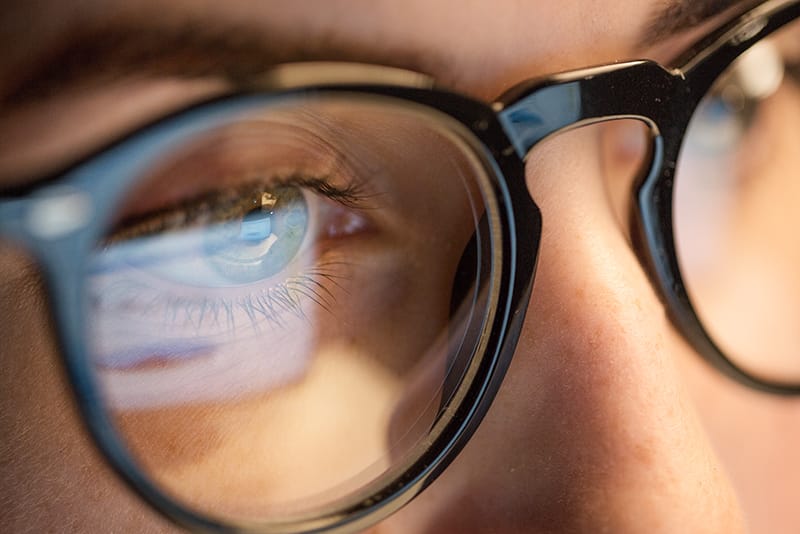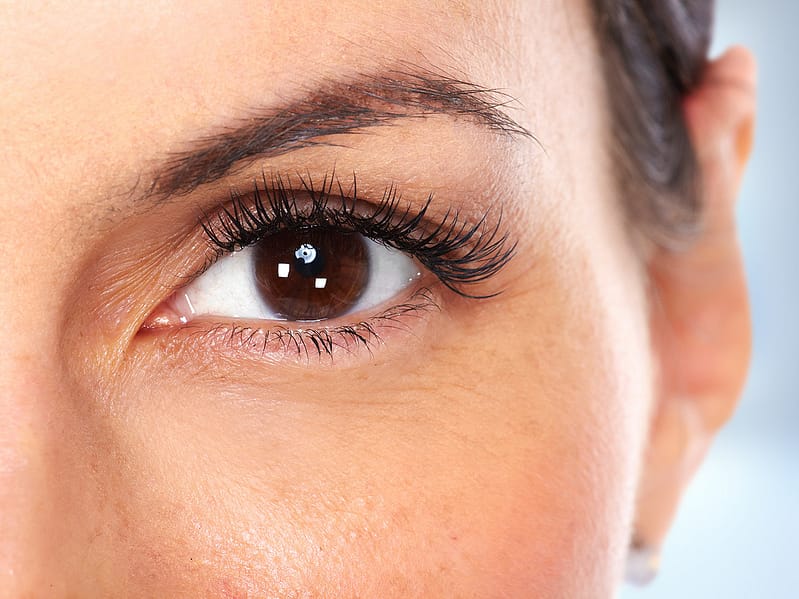Clear, bright eyes are one of the most obvious signs of good health. They give you a more youthful, vibrant and attractive appearance. Red eyes instantly make you look older, tired and unhealthy.
But red, dry, and itchy eyes are often more than just an annoying superficial problem. Besides the common culprit of allergies, these symptoms can stem from inflammation, infections and hormonal imbalances as well as strain from overuse and improper care.
Using whitening drops like Visine to get rid of redness doesn’t solve the root cause of the problem and may actually make it worse over time. That’s because the active ingredient can cause more irritation when used too frequently, leading to rebound redness. Finding the source of your symptoms is important for preserving the longterm health of your eyes and your vision.
So what are some of the common causes of these symptoms and the best ways to relieve them?
Allergies
If your normally bright eyes are irritated from allergies, that itchy feeling is due to a release of histamines which are a component of your immune system. Histamines are chemicals released to fight off what the immune system “sees” as harmful invaders. Some of the most common triggers that cause the release of histamines are pollen and pet dander. Unfortunately for allergy sufferers, the histamine itself causes redness, itching and swelling of the eyes.
In the case of irritated eyes due to allergies, over the counter antihistamine eye drops can help. Some, like Alaway and Zaditor are topical antihistamine drops that can give quick relief from that itchy feeling. They need to be reapplied every 8 to 12 hours. Pataday is a once per day drop that is now available over the counter.
Oral antihistamines tablets, like Claritin, can also help relieve systemic symptoms of allergies—like sneezing and runny nose—but may actually make allergic eye symptoms worse in the long term by drying out your eyes even more.
Whatever you do, try not to rub your eyes when you have allergy symptoms. It only makes the itching worse by releasing more histamines and can lead to broken capillaries and damage to sensitive tissues. Whenever possible, try using a warm compress instead. Soak a clean cloth or cotton pad in warm water and place it over your eyes for several minutes. It will help with itching, swelling and redness.
Finally, try to isolate what you think may be causing your allergy and avoid it as much as possible.
Lack of Tears & Oils
Healthy eyes produce a film of tears and oils that cover the surface of the eye. Tears are produced by the lacrimal glands and oils are produced by the meibomian glands located on the inner eyelids. This protective layer keeps the eyes clear of debris and protects them from scratches and other irritants. When these glands don’t produce enough tears or oils, the surface of the eyes can become dry, irritated and prone to damage and infections.
An opthamologist can do a simple procedure called a Schirmer’s test to determine whether your eyes are producing enough tears to keep your eyes lubricated. Inadequate tear production can have many causes including medical conditions like diabetes, certain medications or vitamin deficiencies. Your doctor may recommend punctal plugs which seal off the tear ducts. Since tear ducts drain tears away from the eyes, sealing them off allows tears to stay on the surface of the eye longer. A lubricant eye drop like Systane soothes dry eyes, giving immediate but temporary relief and has to be reapplied throughout the day. Restasis, an eye drop available by prescription, can help eyes produce more tears over time.
Your doctor can also evaluate how quickly the tears evaporate from the surface of the eye. Even when your eyes produce enough tears, they may dry up too quickly, indicating there aren’t enough oils present to stabilize the tear layer. This can be due to inflammation and the oil glands becoming clogged with debris. Your eye doctor may massage and express your oil glands to remove the buildup. Warm compresses can also help open up clogged meibomian glands, helping them release more oils into the tear layer. If compresses and massage don’t relieve symptoms, there are other alternatives your doctor might recommend like Intense Pulsed Light (IPL) treatments.
Inflammation
Another potential cause of eye discomfort is inflammation. Blepharitis is a chronic inflammation of the eyelids that can be caused by bacteria or skin conditions like dandruff and rosacea. Symptoms of blepharitis include swelling, itching, redness and the chronic feeling of something stuck in the eye. These symptoms result from the flaking off of tissues around eyes. This can lead to a lack of protective oils produced by the Meibomian glands in the eyelids when they become clogged up from inflammation and debris.
Treatment of blepharitis depends on what’s causing it. Antibiotic ointments are sometimes prescribed to treat bacterial causes. Daily warm compresses are also helpful for clearing debris from oil glands and soothing inflammation. If dandruff is a contributing factor, using a dandruff shampoo can also help control the symptoms. In more extreme cases, your doctor may prescribe steroids to help control the inflammation. Other options include intense pulsed light treatments to decrease inflammation and lid debridements to unclog oil glands.
Infection
Infection of the eyes causes symptoms like burning, swelling, itching and redness. Conjunctivitis, commonly called pink eye, is a common condition that most people have experienced at one time or another. Conjunctivitis can be caused by both bacterial and viral infections and it can be highly contagious.
Many cases of conjunctivitis are viral and, as with other viral infections, take time to run their course– often ten days to two weeks. In the meantime, warm compresses and even home remedies like warm chamomile tea bags placed over the eyes a few times each day can help relieve itching and swelling. If you have conjunctivitis, you shouldn’t wear contacts until the infection clears.
If conjunctivitits is caused by a bacteria, it will likely clear without treatment over the course of a few weeks, as well. Antibiotic eye drops are sometimes prescribed but often not necessary for treatment.
To prevent eye infections in the first place don’t share eye makeup with others. Keep your own cosmetics and brushes as clean as possible. Never let your eye pencils touch anything other than your eyes to minimize the chance of picking up bacteria. Also, replace your mascara every three months to prevent buildup of bacteria that can transfer to your eyes, especially if you’re prone to rubbing them.
Most importantly, do your best to break the habit of touching or rubbing your eyes. It’s hard to overstate the amount of potentially infectious materials you could be transferring to your eyes without realizing it, just from common surfaces like doorknobs, keyboards and your phone, to name a few.
Hormonal Changes
Another potential cause of dry, irritated eyes is hormonal imbalance. Sixty percent of women going through perimenopause experience dry eye symptoms caused by changes in estrogen and testosterone levels. This can also happen after a hysterectomy when hormone levels are dramatically altered. Estrogen and testosterone both affect the function of the lacrimal and meibomian glands. As hormone levels fluctuate, tear and oil production can diminish, leading to dry eye symptoms.
If you suspect your dry eye symptoms are due to hormonal changes, you might want to make an appointment with a hormone specialist. They are experts in helping women navigate the sometimes rocky road of perimenopause. Practitioners with in-depth knowledge about hormone imbalances and deficiencies can help reduce and even eliminate the symptoms of perimenopause that many women suffer through unnecessarily for years.
If you go this route, it’s important to find someone with expertise in the area who can give you the most up to date options including bioidentical hormone replacement therapy.
In the meantime, it may help to use lubricating drops to help protect and soothe your eyes and include omega-3 fatty acids in your diet from sources like salmon, mackerel, walnuts, flaxseed and chia seeds (or take omega-3 supplements). Other supplements important for eye health include vitamins A and E and zinc. Take special care to not stress or overuse your eyes and protect them from environmental causes of irritation.
Environmental Causes

Wind, dust and sun
Sometimes, the simple act of physically protecting your eyes from the environment can make a huge difference in your comfort and the appearance of your eyes. Wearing sunglasses in bright sunlight shields your eyes from UV rays and also can help protect against dust and drying wind.
Chemicals
It might seem obvious but try to avoid getting harsh chemicals in your eyes that cause them to sting or burn. This includes sunscreen, soap and shampoo. Instead of using harsh industrial cleaners with fumes that irritate your eyes, try natural alternatives like vinegar, baking soda and lemon juice for everyday cleaning jobs.
Screentime
Screen time is another big offender when it comes to bloodshot, strained and irritated eyes. Most of us spend too much time on screens each day to the detriment of our eye health. Train yourself to spend no more than 30 minutes at a time without taking a break. Set a timer if you need to. That goes for your phone as well.
Taking care of your eyes is a vital part of your overall health and wellness routine and will contribute to an overall more youthful and healthy appearance. But more importantly, you’ll be protecting one of your most precious assets—your ability to clearly see the world around you and those you love.



